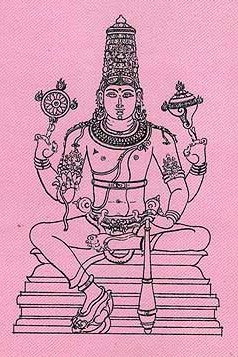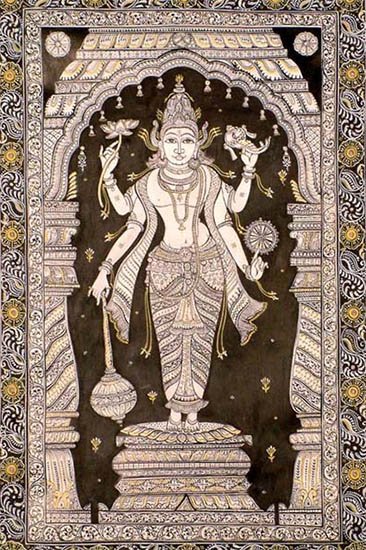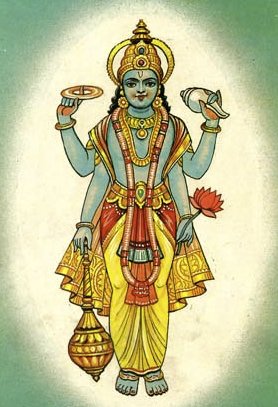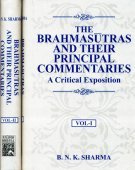Antaryamin, Antaryāmin, Antaryāmī, Antaryami, Antar-yamin, Amtaryami: 19 definitions
Introduction:
Antaryamin means something in Hinduism, Sanskrit, Marathi, Hindi. If you want to know the exact meaning, history, etymology or English translation of this term then check out the descriptions on this page. Add your comment or reference to a book if you want to contribute to this summary article.
In Hinduism
Pancaratra (worship of Nārāyaṇa)
Source: archive.org: Isvara Samhita Vol 1Antaryāmin (अन्तर्यामिन्) refers to the fourth of the five-fold manifestation of the Supreme Consciousness the Pāñcarātrins believe in.—Antaryāmin is the form in which he is permeated through the whole universe and thereby regulates and governs it. Some take it to mean the individual soul as well.
Source: SriMatham: Vaiṣṇava Iconology based on Pañcarātra ĀgamaThe human body is the temple for the Indwelling Spirit of God (Antaryāmin). All the various partsof the temple structure correspond to various parts of the human body. The temple is the physicalbody which houses the presence of God. So the actual building of the temple itself is a symbol of thepresence of God in the world. The temple with all its intricate imagery represents the universe in allits variety and just as on the macrocosmic scale the universe is thebodyof the Lord so on amicrocosmic scale when the icon represents the manifested Lord; the temple is His Body.

Pancaratra (पाञ्चरात्र, pāñcarātra) represents a tradition of Hinduism where Narayana is revered and worshipped. Closeley related to Vaishnavism, the Pancaratra literature includes various Agamas and tantras incorporating many Vaishnava philosophies.
Shilpashastra (iconography)
Source: Shodhganga: The significance of the mūla-beras (śilpa)Antaryāmi (अन्तर्यामि) refers to a classification of Hindu images, as defined in the texts dealing with śilpa (arts and crafs), known as śilpaśāstras.—Images are classified into five forms, namely parama, vyūha, vibhāva, antaryāmi and arcā. Antaryāmi is the name given to the inner image held in intense worship within the beings of devotees. The ability to confirm and act from a self–contained energy is known as antaryāmitva. Antaryāmi is the essentially subtle state of existence of the Divine within our consciousness and within the beings of all substances.

Shilpashastra (शिल्पशास्त्र, śilpaśāstra) represents the ancient Indian science (shastra) of creative arts (shilpa) such as sculpture, iconography and painting. Closely related to Vastushastra (architecture), they often share the same literature.
Vaishnavism (Vaishava dharma)
Source: Pure Bhakti: Bhagavad-gita (4th edition)Antaryāmī (अन्तर्यामी) refers to “in-dwelling witness, the Supersoul, who guides the activities of all living entities”. (cf. Glossary page from Śrīmad-Bhagavad-Gītā).

Vaishnava (वैष्णव, vaiṣṇava) or vaishnavism (vaiṣṇavism) represents a tradition of Hinduism worshipping Vishnu as the supreme Lord. Similar to the Shaktism and Shaivism traditions, Vaishnavism also developed as an individual movement, famous for its exposition of the dashavatara (‘ten avatars of Vishnu’).
Purana and Itihasa (epic history)
Source: archive.org: Shiva Purana - English TranslationAntaryāmin (अन्तर्यामिन्) refers to the “immanent soul” and is used to describe Śiva, according to the Śivapurāṇa 2.3.10.—Accordingly, as Brahmā narrated to Nārada:—“[...] The drops of sweat caused by exhaustion fell on the Earth from the lord’s forehead and took the shape of a child immediately. [...] Afraid of Śiva, the Earth pondered deeply over it and appeared before him in the guise of a good lady. [...] Śiva knew that she was the Earth. Śiva, the cause of protection and enjoyment, the immanent soul [i.e., antaryāmin], on seeing her activities became contented and eagerly said to her laughingly. [...]”.

The Purana (पुराण, purāṇas) refers to Sanskrit literature preserving ancient India’s vast cultural history, including historical legends, religious ceremonies, various arts and sciences. The eighteen mahapuranas total over 400,000 shlokas (metrical couplets) and date to at least several centuries BCE.
Languages of India and abroad
Marathi-English dictionary
Source: DDSA: The Molesworth Marathi and English DictionaryAntaryāmī (अन्तर्यामी).—a (S) Intimate, familiar, near and dear.
Source: DDSA: The Aryabhusan school dictionary, Marathi-EnglishAntaryāmī (अन्तर्यामी).—a Familiar, intimate, near and dear
Marathi is an Indo-European language having over 70 million native speakers people in (predominantly) Maharashtra India. Marathi, like many other Indo-Aryan languages, evolved from early forms of Prakrit, which itself is a subset of Sanskrit, one of the most ancient languages of the world.
Sanskrit dictionary
Source: DDSA: The practical Sanskrit-English dictionaryAntaryāmin (अन्तर्यामिन्).—m.
1) regulating the soul or internal feelings, soul; Providence, Supreme Spirit as guiding and regulating mankind. Brahman; (according to the Bṛ. Ār. Up. antaryāmina 'the internal check' is the Supreme Being and not the individual soul; who standing in the earth is other than the earth, whom the earth knows not, whose body the earth is, who internally restrains and governs the earth; the same is thy soul (and mine, the internal check antaryāmin, &c. &c.); अन्तराविश्य भूतानि यो बिभर्त्यात्मकेतुभिः । अन्तर्या- मीश्वरः साक्षाद्भवेत् (antarāviśya bhūtāni yo bibhartyātmaketubhiḥ | antaryā- mīśvaraḥ sākṣādbhavet) &c.
2) wind; °ब्राह्मणम् (brāhmaṇam) Name of a Brāhmaṇa included in the Bṛ. Ār. Up.
Antaryāmin is a Sanskrit compound consisting of the terms antar and yāmin (यामिन्).
Source: Cologne Digital Sanskrit Dictionaries: Shabda-Sagara Sanskrit-English DictionaryAntaryāmin (अन्तर्यामिन्).—mfn. (-mī-minī-mi) 1. Checking or regulating the internal feelings. 2. Heart-searching or pervading. m. (-mī) 1. The soul. 2. Providence, the Supreme spirit, as regulating and guiding mankind. 3. Conscience. E. antar within, and yāmin who stops or refrains.
Source: Cologne Digital Sanskrit Dictionaries: Benfey Sanskrit-English DictionaryAntaryāmin (अन्तर्यामिन्).— i. e. antar -yam + in, m. The soul, [Vedāntasāra, (in my Chrestomathy.)] in
Antaryāmin (अन्तर्यामिन्).—[masculine] the inward regulator (ph.).
Source: Cologne Digital Sanskrit Dictionaries: Monier-Williams Sanskrit-English DictionaryAntaryāmin (अन्तर्यामिन्):—[=antar-yāmin] m. ‘checking or regulating the internal feelings’, the soul, [Śatapatha-brāhmaṇa xiv; Muṇḍaka-upaniṣad]
Source: Cologne Digital Sanskrit Dictionaries: Goldstücker Sanskrit-English DictionaryAntaryāmin (अन्तर्यामिन्):—[tatpurusha compound] m.
(-mī) 1) (In the Upan. and the oldest Vedānta phil.) The supreme Soul as the inward regulator of all the phenomena of the material and intellectual world, in this and in a future life: ‘ya imaṃ ca lokaṃ paraṃ ca lokaṃ sarvāṇi ca bhūtānyantaro yamayati’; ‘adhidaivatamadhilokamadhivedamadhiyajñamadhibhūtamadhyātmaṃ ca kaścidantaravasthito yamayitāntaryāmī’; not merely ‘the individual Soul of a divinity, of a living being &c.’, but the same as the paramātman; ‘antaryāmyadhidaivādiṣu taddharmavyapadeśāt’…‘tasmātparamātmaivāntaryāmī’.—
2) (In the later Vedānta.) Brahman (m.) as creator of the world when under the influence of the first Gunā or of the cosmical quality of sattva ‘goodness’; as such however, he is not the purest form of Brahman, but inferior to Īśa who is freed of all cosmical qualities.
3) (In the Vedānta applied to the doctrine of the sects.) [a.]) Viṣṇu or Purushottama when becoming human or individual Soul; e. g. antaḥ praviśya bhūtāni yo bibhartyātmaketubhiḥ . antaryāmīśvaraḥ sākṣātpātu no yadvaśe sphuṭam ..; [b.]) Śiva. E. antar and yāmin.
Source: Cologne Digital Sanskrit Dictionaries: Yates Sanskrit-English DictionaryAntaryāmin (अन्तर्यामिन्):—[antar-yāmin] (mī) 5. m. All-pervading spirit. a. Heart-searching.
[Sanskrit to German]
Sanskrit, also spelled संस्कृतम् (saṃskṛtam), is an ancient language of India commonly seen as the grandmother of the Indo-European language family (even English!). Closely allied with Prakrit and Pali, Sanskrit is more exhaustive in both grammar and terms and has the most extensive collection of literature in the world, greatly surpassing its sister-languages Greek and Latin.
Hindi dictionary
Source: DDSA: A practical Hindi-English dictionaryAṃtaryāmī (अंतर्यामी) [Also spelled antaryami]:—(a) pervading the interior or inner self; (nm) the Supreme Spirit.
Source: DDSA: A practical Hindi-English dictionaryAntaryami in Hindi refers in English to:—(a) pervading the interior or inner self; (nm) the Supreme Spirit..—antaryami (अंतर्यामी) is alternatively transliterated as Aṃtaryāmī.
...
Kannada-English dictionary
Source: Alar: Kannada-English corpusAṃtaryāmi (ಅಂತರ್ಯಾಮಿ):—
1) [noun] the Supreme, who being immanent in all beings and governs their minds.
2) [noun] the individual soul.
3) [noun] one of the vital air essential for all actions in the body.
Kannada is a Dravidian language (as opposed to the Indo-European language family) mainly spoken in the southwestern region of India.
See also (Relevant definitions)
Starts with: Antaryaminca.
Ends with: Sarvantaryamin.
Full-text: Yami, Antaryaman, Carvantaryami, Antaryama, Vibhava, Parama, Hricchaya, Arca, Vyuha, Ishvara, Abhyasa, Pancaratra.
Relevant text
Search found 40 books and stories containing Antaryamin, Aṃtaryāmi, Aṃtaryāmī, Amtaryami, Antar-yāmin, Antar-yamin, Antaryāmī, Antaryāmi, Antaryami, Antaryāmin; (plurals include: Antaryamins, Aṃtaryāmis, Aṃtaryāmīs, Amtaryamis, yāmins, yamins, Antaryāmīs, Antaryāmis, Antaryamis, Antaryāmins). You can also click to the full overview containing English textual excerpts. Below are direct links for the most relevant articles:
A History of Indian Philosophy Volume 4 (by Surendranath Dasgupta)
Part 2 - The nature of Brahman < [Chapter XXXI - The Philosophy of Vallabha]
Part 5 - Concept of bhakti < [Chapter XXXI - The Philosophy of Vallabha]
Part 5 - Nature of bhakti < [Chapter XXXIII - The Philosophy of Jiva Gosvāmī and Baladeva Vidyābhūṣaṇā]
Chandogya Upanishad (Madhva commentary) (by Srisa Chandra Vasu)
Fourth Adhyaya, Eleventh through Fifteenth Khandas (15 mantras)
The Bhagavata Purana (by G. V. Tagare)
Chapter 6 - Appeasement of Rudra—Revival of Dakṣa < [Book 4 - Fourth Skandha]
Chapter 16 - Instruction in the observance of Payovrata to Aditi < [Book 8 - Eighth Skandha]
Chapter 9 - Viṣṇu’s boon and Dhruva’s Coronation < [Book 4 - Fourth Skandha]
Shrimad Bhagavad-gita (by Narayana Gosvami)
Verse 18.62 < [Chapter 18 - Mokṣa-yoga (the Yoga of Liberation)]
Verse 8.4 < [Chapter 8 - Tāraka-brahma-yoga (the Yoga of Absolute Deliverance)]
Verse 7.21 < [Chapter 7 - Vijñāna-Yoga (Yoga through Realization of Transcendental Knowledge)]
Brahma Sutras (Shankaracharya) (by George Thibaut)
Chaitanya Bhagavata (by Bhumipati Dāsa)
Verse 1.1.80 < [Chapter 1 - Summary of Lord Gaura’s Pastimes]
Verse 2.16.57 < [Chapter 16 - The Lord’s Acceptance of Śuklāmbara’s Rice]
Verse 1.17.144 < [Chapter 17 - The Lord’s Travel to Gayā]
Related products

